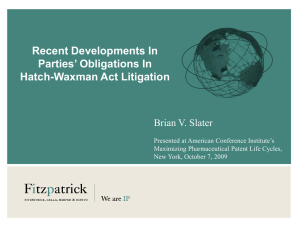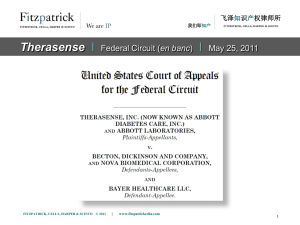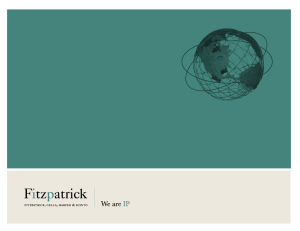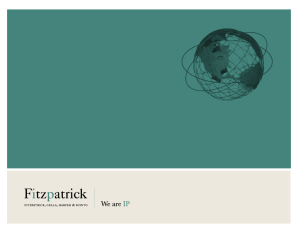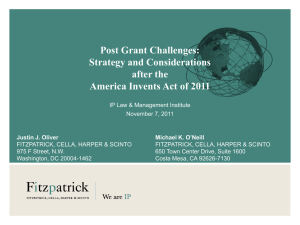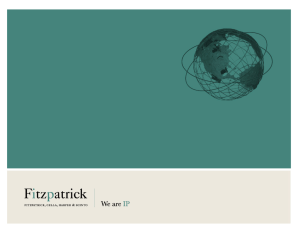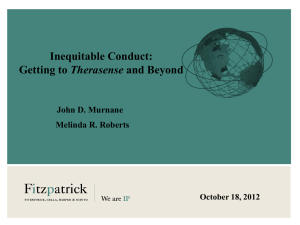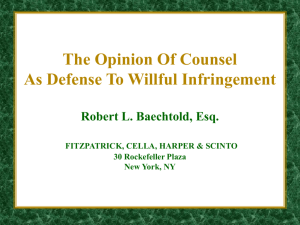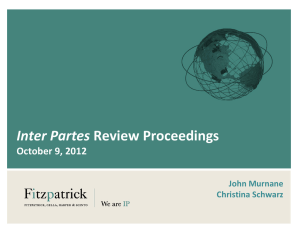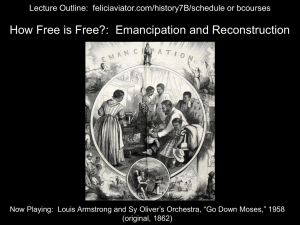飞泽知识产权律师所 - Fitzpatrick, Cella, Harper & Scinto
advertisement
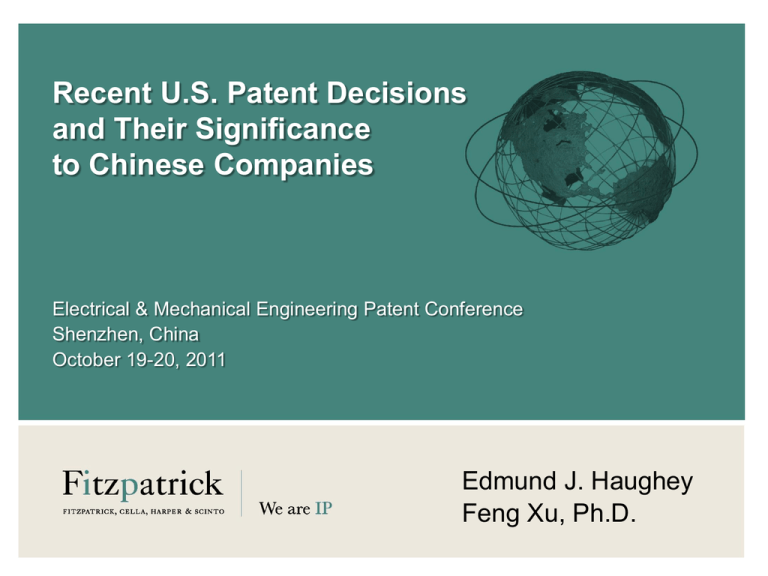
Recent U.S. Patent Decisions and Their Significance to Chinese Companies Electrical & Mechanical Engineering Patent Conference Shenzhen, China October 19-20, 2011 Edmund J. Haughey Feng Xu, Ph.D. 飞泽知识产权律师所 我们即知产 About Us More than 175 lawyers Exclusively Intellectual Property law Patents Trademarks Copyrights Trade Secrets Litigation Prosecution Licensing Due Diligence Coast to coast presence in three major business and regulatory hubs of the U.S. (New York, Washington D.C., and California) FITZPATRICK, CELLA, HARPER & SCINTO © 2011 | www.fitzpatrickcella.com 2 飞泽知识产权律师所 我们即知产 About Us ǀ Industries & Clients Served Electronics & Computers Becton Dickinson Canon Nanotechnology Pharmaceuticals, Chemicals & Biotechnology FITZPATRICK, CELLA, HARPER & SCINTO © 2011 | www.fitzpatrickcella.com HewlettPackard IBM Johnson The Clearing Outdoors House Payments Medtronic Company Reliable Electrolux Sprinkler Co. Entegris Sirona Dental GeorgiaSystems Pacific 3 飞泽知识产权律师所 我们即知产 About Us ǀ Technical Qualifications Electrical Computers Mechanical Engineering Biology Biochemistry Biotechnology Technical Degrees Chemistry FITZPATRICK, CELLA, HARPER & SCINTO © 2011 | Other, e.g., Physics, Materials Engineering, Civil Engineering, Environmental Engineering, Neuroscience, Pharmacology www.fitzpatrickcella.com 4 飞泽知识产权律师所 我们即知产 About Us ǀ Recent Accolades Leading Firm in Intellectual Property ǀ Chambers Global 2011 Band 1 Intellectual Property Firm ǀ Chambers USA 2010 Tier 1 Patent Litigation Firm ǀ IAM Patent Litigation 250 2011 Leading Firm ǀ PLC Which Lawyer 2011 Top Patent Prosecution Firms ǀ Intellectual Property Today Tier 1 for Intellectual Property ǀ Benchmark: The Definitive Guide to America's Leading Litigation Firms & Attorneys 2011 National Tier 1 and New York Tier 1 Firm for Intellectual Property Law ǀ U.S. News & World Report 2010 Best US IP Law Firm ǀ International Legal Alliance Summit and Awards 2010 FITZPATRICK, CELLA, HARPER & SCINTO © 2011 | www.fitzpatrickcella.com 5 飞泽知识产权律师所 我们即知产 Overview of Presentation Review of significant decisions by the U.S. Supreme Court and the Federal Circuit from the past year relating to the electrical, mechanical, and computer arts. Global-Tech v. SEB Therasense v. Becton Microsoft v. i4i CyberSource v. Retail Decisions Hyatt v. Kappos Ultramercial v. Hulu TiVo v. EchoStar Akamai v. Limelight Uniloc v. Microsoft McKesson v. Epic Lessons to be learned from these decisions. FITZPATRICK, CELLA, HARPER & SCINTO © 2011 | www.fitzpatrickcella.com 6 飞泽知识产权律师所 我们即知产 Global-Tech v. SEB ǀ The Case FITZPATRICK, CELLA, HARPER & SCINTO © 2011 | U.S. Supreme Court www.fitzpatrickcella.com ǀ May 31, 2011 7 飞泽知识产权律师所 我们即知产 Global-Tech v. SEB ǀ Issue What is the proper intent standard for proving induced infringement under 35 U.S.C. § 271(b)? FITZPATRICK, CELLA, HARPER & SCINTO © 2011 | www.fitzpatrickcella.com 8 飞泽知识产权律师所 我们即知产 Global-Tech v. SEB ǀ Facts SEB invented and patented a “cool touch” deep fryer. Global-Tech’s subsidiary, Pentalpha, purchased SEB’s commercial fryer outside the U.S. and copied all but the fryer’s cosmetic features. Pentalpha hired U.S. attorney to conduct right-to-use study, but did not tell attorney it had copied SEB’s design. Attorney did not find SEB’s patent and issued favorable opinion. Pentalpha then started selling its fryers to Sunbeam for resale in U.S. FITZPATRICK, CELLA, HARPER & SCINTO © 2011 | www.fitzpatrickcella.com 9 飞泽知识产权律师所 我们即知产 Global-Tech v. SEB ǀ Holding Induced infringement requires actual knowledge that the induced acts constitute patent infringement. Deliberate indifference does not satisfy the knowledge requirement, but willful blindness does. Willful blindness occurs: (1) when the defendant subjectively believes there is a high probability that a fact exists; and (2) the defendant takes deliberate actions to avoid learning of that fact. FITZPATRICK, CELLA, HARPER & SCINTO © 2011 | www.fitzpatrickcella.com 10 飞泽知识产权律师所 我们即知产 Global-Tech v. SEB ǀ Lessons #1 Blinding oneself to probable risks is not a viable patent defense strategy. #2 Copying another’s product is inherently risky. #3 A competent opinion from U.S. counsel can be a useful defense to induced infringement, but be sure to provide full disclosure. #4 Patent owners: Make the risk obvious to would-be infringers. #5 Potential ramifications for willful infringement? FITZPATRICK, CELLA, HARPER & SCINTO © 2011 | www.fitzpatrickcella.com 11 飞泽知识产权律师所 我们即知产 Microsoft v. i4i ǀ The Case FITZPATRICK, CELLA, HARPER & SCINTO © 2011 U.S. Supreme Court | www.fitzpatrickcella.com ǀ Jun. 9, 2011 12 飞泽知识产权律师所 我们即知产 Microsoft v. i4i ǀ Issue What is the proper standard of proof for overcoming a patent’s presumption of validity? FITZPATRICK, CELLA, HARPER & SCINTO © 2011 | www.fitzpatrickcella.com 13 飞泽知识产权律师所 我们即知产 Microsoft v. i4i ǀ Facts Patentee i4i sued Microsoft for willful infringement of a patent claiming an improved method for editing computer documents. Microsoft asserted that i4i’s patent was invalid based on i4i’s sale of its S4 software more than one year before the patent filing date. Undisputed that the S4 software was never considered by the PTO examiner during prosecution. Microsoft objected to “clear and convincing evidence” jury instruction, and instead requested “preponderance of the evidence” instruction. Court gave “clear and convincing evidence” instruction, and jury found patent valid and willfully infringed. FITZPATRICK, CELLA, HARPER & SCINTO © 2011 | www.fitzpatrickcella.com 14 飞泽知识产权律师所 我们即知产 Microsoft v. i4i ǀ Holding Invalidity must be established by clear and convincing evidence. Burden does not vary depending on whether the asserted prior art was considered by the PTO. Jury may be instructed to evaluate whether the prior art before it is materially new, and if so, to consider that fact when determining whether an invalidity defense has been proved by clear and convincing evidence. FITZPATRICK, CELLA, HARPER & SCINTO © 2011 | www.fitzpatrickcella.com 15 飞泽知识产权律师所 我们即知产 Microsoft v. i4i ǀ Lessons #1 When attacking a patent’s validity, preferable to rely on prior art not considered by the PTO. #2 Seek “materially new” jury instruction when arguing invalidity based on new prior art. #3 Instead of attacking validity with prior art previously considered by the PTO, consider using such art in arguing for a narrow claim construction. #4 Consider reexamination or post grant review, where there is no presumption of validity and the lower preponderance of the evidence standard applies. FITZPATRICK, CELLA, HARPER & SCINTO © 2011 | www.fitzpatrickcella.com 16 飞泽知识产权律师所 我们即知产 Hyatt v. Kappos ǀ The Case FITZPATRICK, CELLA, HARPER & SCINTO © 2011 | Federal Circuit (en banc) www.fitzpatrickcella.com ǀ Nov. 8, 2010 17 飞泽知识产权律师所 我们即知产 Hyatt v. Kappos ǀ Issue Whether a patent applicant who sues the PTO in district court (a Section 145 civil action) may introduce new evidence that could have been presented to the PTO in the first instance? FITZPATRICK, CELLA, HARPER & SCINTO © 2011 | www.fitzpatrickcella.com 18 飞泽知识产权律师所 我们即知产 Hyatt v. Kappos ǀ Facts Hyatt applied for a patent related to a computerized display system for processing image information. PTO examiner issued 2,546 separate rejections of 117 claims. PTO Board reversed 93% of rejections, but affirmed rejections based on written description and enablement. Hyatt filed a Section 145 civil action, but lost on summary judgment when the court refused to consider his declaration, which, according to the court, could and should have been submitted earlier to the PTO. FITZPATRICK, CELLA, HARPER & SCINTO © 2011 | www.fitzpatrickcella.com 19 飞泽知识产权律师所 我们即知产 Hyatt v. Kappos ǀ Holding Patent applicant may introduce new evidence in a Section 145 civil action, irrespective of whether such evidence could have been presented to the PTO, subject only to the Federal Rules of Evidence and Civil Procedure. Factual issues to which the new evidence pertains must be considered de novo, without deference to the Board. FITZPATRICK, CELLA, HARPER & SCINTO © 2011 | www.fitzpatrickcella.com 20 飞泽知识产权律师所 我们即知产 Hyatt v. Kappos ǀ Lessons #1 A Section 145 civil action is the only option if you need to supplement existing record. #2 Even when existing record is complete, a Section 145 civil action offers applicants an additional chance to prevail before appealing to Federal Circuit. #3 Speed and cost generally favor presenting all available evidence to the PTO examiner. #4 Supreme Court will have the last word. Safest course in meantime is to present all available evidence to the PTO. FITZPATRICK, CELLA, HARPER & SCINTO © 2011 | www.fitzpatrickcella.com 21 飞泽知识产权律师所 我们即知产 TiVo v. EchoStar ǀ The Case FITZPATRICK, CELLA, HARPER & SCINTO © 2011 | Federal Circuit (en banc) www.fitzpatrickcella.com ǀ Apr. 20, 2011 22 飞泽知识产权律师所 我们即知产 TiVo v. EchoStar ǀ Issue What is the standard for determining whether an adjudged infringer is in contempt of an injunction? FITZPATRICK, CELLA, HARPER & SCINTO © 2011 | www.fitzpatrickcella.com 23 飞泽知识产权律师所 我们即知产 TiVo v. EchoStar ǀ Facts TiVo sued EchoStar for infringement of TiVo’s “time warp” patent. Following jury verdict of willful infringement, EchoStar ordered to: (1) stop making, using, offering to sell, and selling infringing DVR receivers; and (2) disable DVR functionality in existing receivers in customers’ homes. EchoStar came out with redesigned DVR product, and TiVo brought contempt proceeding for violation of injunction. District court found EchoStar in contempt and imposed sanctions of nearly $90 million, plus another $110 million for continued infringement. FITZPATRICK, CELLA, HARPER & SCINTO © 2011 | www.fitzpatrickcella.com 24 飞泽知识产权律师所 我们即知产 TiVo v. EchoStar ǀ Holding Contempt finding requires clear and convincing evidence that: (1) the newly accused product is not more than colorably different from the product found to infringe; and (2) the newly accused product actually infringes. Colorable difference test looks to the significance of differences between infringing features of old product and corresponding features of new product. Nonobvious modifications may be significant, while obvious ones may not be. After-the-fact arguments that an injunction is unduly vague or overbroad are unlikely to prevail in a contempt proceeding. FITZPATRICK, CELLA, HARPER & SCINTO © 2011 | www.fitzpatrickcella.com 25 飞泽知识产权律师所 我们即知产 TiVo v. EchoStar ǀ Lessons #1 Good faith alone is not a defense. Better be correct as well. #2 A successful design-around begins with significantly modifying or removing at least one feature previously adjudged to satisfy a claim limitation. #3 Innovative design-arounds are more likely to avoid a contempt finding than obvious ones. #4 Appeal or seek clarification/modification of vague or overbroad injunctions immediately. Do not take it upon yourself to decide what is and is not enjoined. FITZPATRICK, CELLA, HARPER & SCINTO © 2011 | www.fitzpatrickcella.com 26 飞泽知识产权律师所 我们即知产 Uniloc The Casev. Microsoft ǀ FITZPATRICK, CELLA, HARPER & SCINTO © 2011 | Federal Circuit www.fitzpatrickcella.com ǀ Jan. 4, 2011 27 飞泽知识产权律师所 我们即知产 Uniloc v. Microsoft ǀ Issue Whether the “25 percent rule” is a permissible starting point for determining reasonable royalty damages? FITZPATRICK, CELLA, HARPER & SCINTO © 2011 | www.fitzpatrickcella.com 28 飞泽知识产权律师所 我们即知产 Uniloc v. Microsoft ǀ Facts Uniloc sued Microsoft for infringement of a patent directed to a software registration system to deter copying of software. Jury returned verdict of willful infringement by Microsoft. Uniloc awarded $388 million in reasonable royalty damages based on “25 percent rule.” FITZPATRICK, CELLA, HARPER & SCINTO © 2011 | www.fitzpatrickcella.com 29 飞泽知识产权律师所 我们即知产 Uniloc v. Microsoft ǀ Holding The “25 percent rule” is a fundamentally flawed tool for determining a baseline royalty rate in a hypothetical negotiation. Evidence relying on the “25 percent rule” is inadmissible under Daubert and Federal Rule of Evidence 702. Reasonable royalty damages must be determined under the unique facts of each case according to the Georgia-Pacific Factors, without using the “25 percent rule” as a starting point. Reference to total product revenues is inappropriate, even as a “check,” unless entire market value rule is satisfied. FITZPATRICK, CELLA, HARPER & SCINTO © 2011 | www.fitzpatrickcella.com 30 飞泽知识产权律师所 我们即知产 Uniloc v. Microsoft ǀ Lessons #1 Facts, facts, and more facts. #2 Increased use of Daubert challenges. #3 Cross-examine your own damages expert early and often. #4 Accused infringers: If entire market value rule does not apply, seek to preclude prejudicial references to total product revenues. FITZPATRICK, CELLA, HARPER & SCINTO © 2011 | www.fitzpatrickcella.com 31
